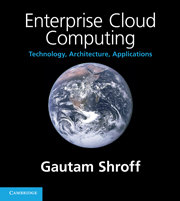Book contents
- Frontmatter
- Contents
- Preface
- List of abbreviations
- Part I Computing platforms
- Part II Cloud platforms
- Part III Cloud technologies
- Chapter 7 Web services, AJAX and mashups
- Chapter 8 Virtualization technology
- Chapter 9 Multi-tenant software
- Part IV Cloud development
- Part V Software architecture
- Part VI Enterprise cloud computing
- References
- Index
Chapter 7 - Web services, AJAX and mashups
Published online by Cambridge University Press: 06 December 2010
- Frontmatter
- Contents
- Preface
- List of abbreviations
- Part I Computing platforms
- Part II Cloud platforms
- Part III Cloud technologies
- Chapter 7 Web services, AJAX and mashups
- Chapter 8 Virtualization technology
- Chapter 9 Multi-tenant software
- Part IV Cloud development
- Part V Software architecture
- Part VI Enterprise cloud computing
- References
- Index
Summary
The internet is based on a universally accepted set of protocols, HTTP, DNS, and TCP/IP, that provide the foundation for web-based cloud computing offerings. In this chapter we examine three critical web-based technologies at the next level of granularity that have been instrumental in improving the usability of web-based applications: Web services are used to request for and access infrastructure services in the cloud; AJAX-based user interfaces allow web-based applications to be user friendly; finally mashups bring a new dimension to software as a service by enabling users to compose multiple SaaS applications into a single user interface.
WEB SERVICES: SOAP AND REST
We have discussed the genesis and evolution of web services briefly in Chapter 2. Here we give a brief technical overview of both SOAP/WSDL and REST-based web services, and also compare these in the context of their utility in building cloud-based offerings. For a more detailed description of web services protocols, see [30].
SOAP/WSDL Web services
SOAP/WSDL web services evolved from the need to programmatically interconnect web-based applications. As a result SOAP/WSDL web services are essentially a form of remote procedure calls over HTTP, while also including support for nested structures (objects) in a manner similar to earlier extensions of RPC, such as CORBA; we shall return to this point later.
The elements of a SOAP/WSDL web service are illustrated in Figure 7.1, using as an example the service provided by Google for searching the web.
Information
- Type
- Chapter
- Information
- Enterprise Cloud ComputingTechnology, Architecture, Applications, pp. 77 - 88Publisher: Cambridge University PressPrint publication year: 2010
